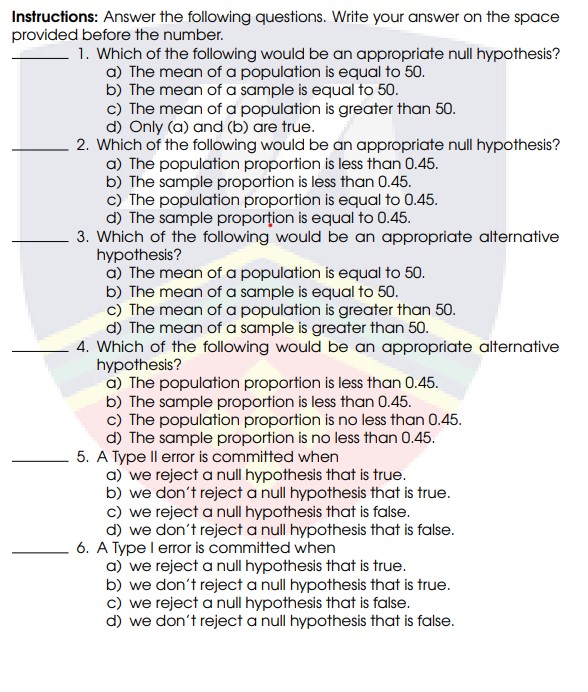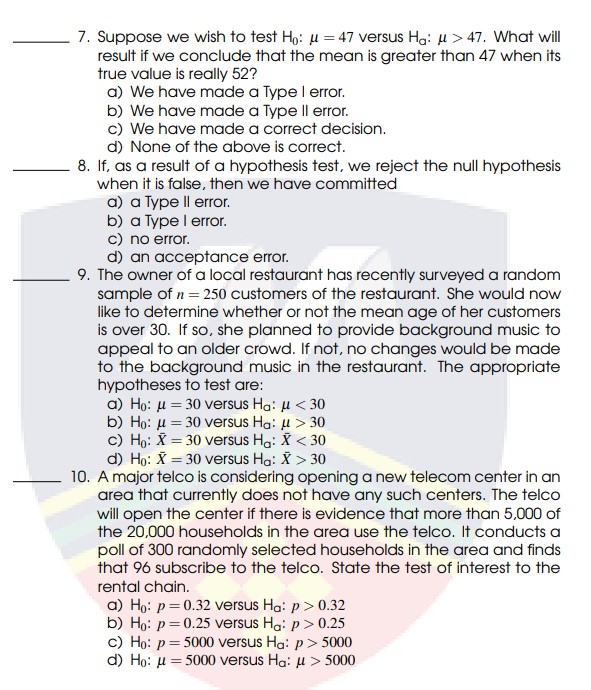ALL ABOUT STATS - NO EXPLANATION NEEDED
Instructions: Answer the following questions. Write your answer on the space provided before the number. 1. Which of the following would be an appropriate null hypothesis? a) The mean of a population is equal to 50. b) The mean of a sample is equal to 50. c) The mean of a population is greater than 50. d) Only (a) and (b) are true. 2. Which of the following would be an appropriate null hypothesis? a) The population proportion is less than 0.45. b) The sample proportion is less than 0.45. c) The population proportion is equal to 0.45. d) The sample proportion is equal to 0.45. 3. Which of the following would be an appropriate alternative hypothesis? a) The mean of a population is equal to 50. b) The mean of a sample is equal to 50. c) The mean of a population is greater than 50. d) The mean of a sample is greater than 50 4. Which of the following would be an appropriate alternative hypothesis? a) The population proportion is less than 0.45. b) The sample proportion is less than 0.45. c) The population proportion is no less than 0.45. d) The sample proportion is no less than 0.45. 5. A Type ll error is committed when a) we reject a null hypothesis that is true. b) we don't reject a null hypothesis that is true. c) we reject a null hypothesis that is false. d) we don't reject a null hypothesis that is false. 6. A Type I error is committed when a) we reject a null hypothesis that is true. b) we don't reject a null hypothesis that is true. c) we reject a null hypothesis that is false. d) we don't reject a null hypothesis that is false.7. Suppose we wish to test Ho: u = 47 versus Ha: u > 47. What will result if we conclude that the mean is greater than 47 when its true value is really 52? a) We have made a Type I error. b) We have made a Type II error. c) We have made a correct decision. d) None of the above is correct. 8. If, as a result of a hypothesis test, we reject the null hypothesis when it is false, then we have committed a) a Type ll error. b) a Type I error. c) no error. d) an acceptance error. 9. The owner of a local restaurant has recently surveyed a random sample of n = 250 customers of the restaurant. She would now like to determine whether or not the mean age of her customers is over 30. If so, she planned to provide background music to appeal to an older crowd. If not, no changes would be made to the background music in the restaurant. The appropriate hypotheses to test are: a) Ho: # = 30 versus Ha: H 30 C) Ho: X = 30 versus Ha: X 30 10. A major telco is considering opening a new telecom center in an area that currently does not have any such centers. The telco will open the center if there is evidence that more than 5,000 of the 20,000 households in the area use the telco. It conducts a poll of 300 randomly selected households in the area and finds that 96 subscribe to the telco. State the test of interest to the rental chain. a) Ho: p= 0.32 versus Ha: p > 0.32 b) Ho: p= 0.25 versus Ha: p > 0.25 C) Ho: p = 5000 versus Ha: p > 5000 d) Ho: u = 5000 versus Ha: H > 5000








